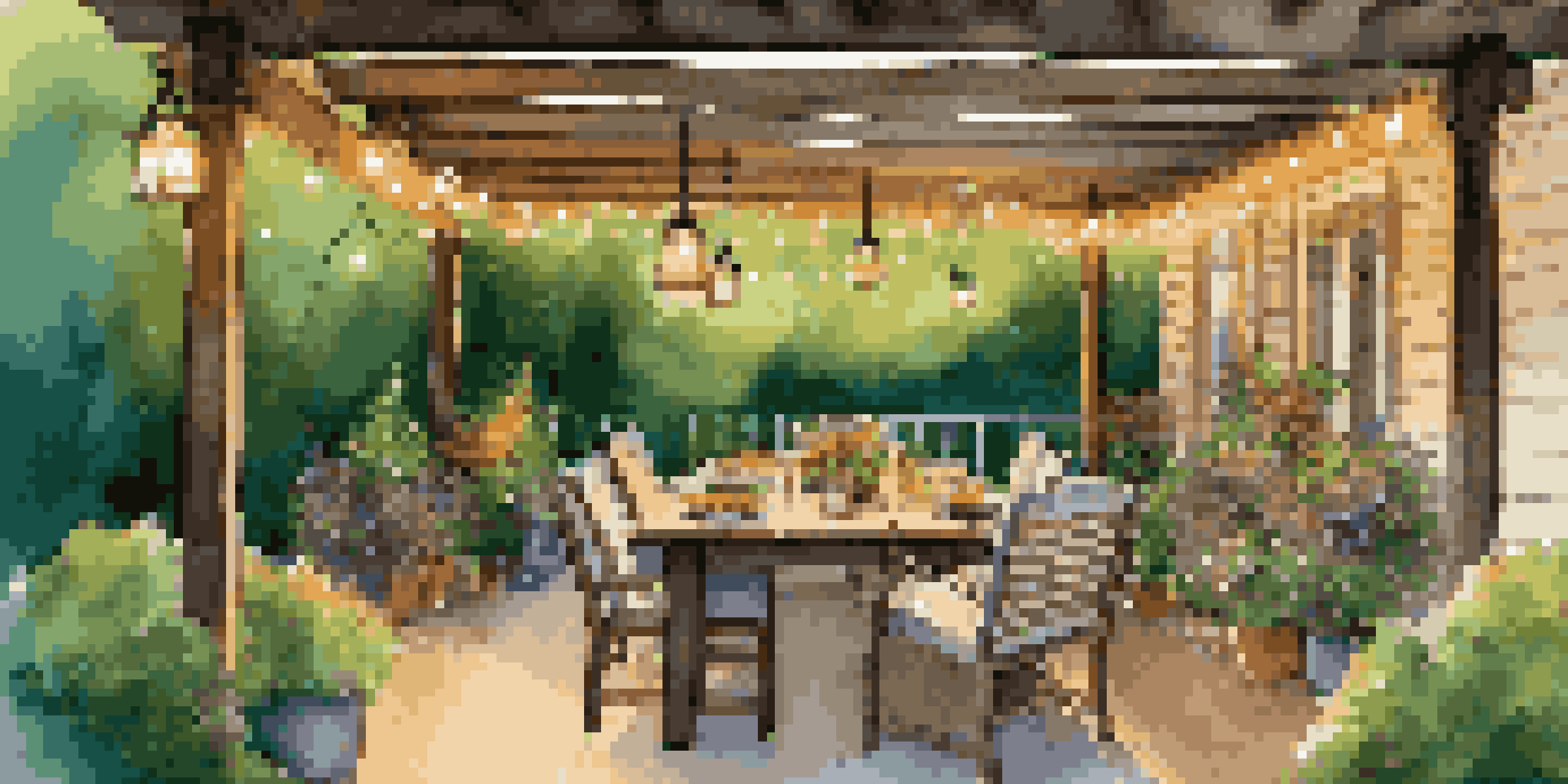Design Considerations for Year-Round Outdoor Living Spaces

Understanding Your Climate for Outdoor Spaces
When designing an outdoor living space, the first step is to understand your local climate. Whether you experience hot summers, chilly winters, or rainy seasons, these factors will greatly influence your design choices. For instance, in warmer areas, you might want to include shade solutions, while colder climates may require heating options.
The outdoors is a place where we can connect with nature, relax, and enjoy the simple pleasures of life.
Additionally, consider how seasonal changes affect the space. Plants that thrive in summer may struggle in the winter, so selecting year-round greenery is crucial. Incorporating native plants can also enhance your outdoor environment by ensuring they withstand local weather conditions.
Ultimately, aligning your design with your climate not only enhances comfort but also prolongs the usability of your outdoor space throughout the year.
Choosing Functional Furniture and Layout
The furniture you select plays a vital role in the functionality of your outdoor space. Opt for weather-resistant materials like aluminum, teak, or synthetic wicker that can withstand the elements. This ensures your investment lasts, regardless of the weather.

Arranging the furniture thoughtfully can create distinct zones for various activities, such as dining, lounging, or entertaining. For example, a cozy seating area around a fire pit invites conversation and warmth during cooler months, while a shaded dining area can be perfect for summer meals.
Climate-Informed Design Choices
Understanding your local climate is essential for selecting the right features and plants to ensure year-round usability of your outdoor space.
Remember, the layout should also consider traffic flow, allowing guests to move comfortably without feeling cramped. A well-planned outdoor space can transform your backyard into a welcoming retreat year-round.
Incorporating Shelter and Shade Solutions
Shelter is a key consideration in year-round outdoor living spaces. Structures such as pergolas, gazebos, or even large umbrellas can provide much-needed shade during the hot summer months. They also create a defined area that feels like an extension of your home.
Nature does not hurry, yet everything is accomplished.
In colder climates, consider adding features like retractable screens or outdoor heaters. These elements allow you to enjoy your space, even when temperatures dip. Imagine hosting a winter gathering under a warm, sheltered area—it's all about maximizing comfort.
Moreover, these structures can enhance the aesthetic appeal of your outdoor area, adding character and style. Choosing materials that complement your home’s architecture can create a cohesive look that ties your indoor and outdoor spaces together.
Lighting: Setting the Mood for Every Season
Lighting is essential in outdoor spaces, as it not only enhances safety but also sets the mood. Consider using a mix of ambient, task, and accent lighting to create a versatile atmosphere. String lights, lanterns, and spotlights can transform your area into a magical setting for evening gatherings.
Incorporating dimmable options allows you to adjust the brightness according to the occasion, whether it's a romantic dinner or a lively family barbecue. Solar-powered lights are another great option, as they’re eco-friendly and easy to install.
Functional Furniture and Layout
Choosing weather-resistant furniture and arranging it thoughtfully can create distinct zones for various activities, enhancing the functionality of your outdoor area.
Thoughtful lighting design can extend the usability of your outdoor space well into the evening, making it a year-round destination for relaxation and entertainment.
Creating Privacy and Comfort with Landscaping
Landscaping plays a significant role in defining your outdoor space and enhancing privacy. Strategically placed trees, shrubs, or trellises can create natural barriers, allowing you to enjoy your area without feeling exposed. This is particularly important in densely populated neighborhoods.
Additionally, using landscaping to create layers can add depth and interest to your outdoor design. For instance, taller plants can shield the view from above while shorter ones can frame seating areas beautifully.
Incorporating elements like water features or decorative rocks can also enhance the ambiance, making your outdoor space feel like a personal oasis. A well-landscaped area not only serves functional purposes but also contributes to the overall serenity of your environment.
Integrating Outdoor Cooking and Dining Areas
Outdoor cooking and dining areas can elevate your outdoor experience, making it more enjoyable and convenient. Consider adding a built-in grill, outdoor kitchen, or a simple fire pit for barbecues that turn into social gatherings. These features encourage cooking and dining under the open sky, creating a unique culinary experience.
Designing a dining area that accommodates your family and friends is equally important. A large table with comfortable seating invites gatherings, while smaller settings can create intimate dining experiences. Don't forget about the proximity to the kitchen for ease of use!
Personal Touches Enhance Appeal
Adding personal accessories and decorative elements not only reflects your style but also creates a welcoming environment for you and your guests.
By integrating cooking and dining into your outdoor design, you create a space that’s perfect for entertaining and enjoying meals together, rain or shine.
Adding Personal Touches and Accessories
Personal touches can make your outdoor living space feel like home. From colorful cushions and throws to decorative planters and art pieces, accessories help reflect your style and personality. These elements can easily be swapped out with the seasons, keeping your space fresh and inviting.
Consider incorporating outdoor rugs to define seating areas and add warmth. They create a cozy atmosphere and help in delineating different zones within your space. Additionally, fabrics that are resistant to fading and mildew can ensure durability.

Ultimately, these personal touches not only enhance the visual appeal but also create a welcoming environment that you and your guests will love to spend time in throughout the year.